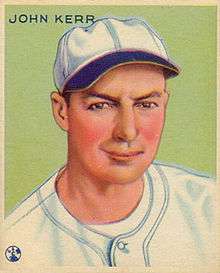John Kerr (baseball)
| John Kerr | |||
|---|---|---|---|
 1933 Goudey baseball card. | |||
| Second baseman | |||
|
Born: November 26, 1898 San Francisco, California | |||
|
Died: October 19, 1993 (aged 94) Long Beach, California | |||
| |||
| MLB debut | |||
| May 1, 1923, for the Detroit Tigers | |||
| Last MLB appearance | |||
| September 30, 1934, for the Washington Senators | |||
| MLB statistics | |||
| Batting average | .266 | ||
| Home runs | 6 | ||
| Runs batted in | 145 | ||
| Teams | |||
| |||
John Francis Kerr (November 26, 1898 – October 19, 1993) was a professional baseball player. He played all or part of eight seasons in Major League Baseball between 1923 and 1934 with the Detroit Tigers, Chicago White Sox, and the Washington Senators in the American League, primarily as a second baseman.
Early career
Kerr made his professional baseball debut in 1923. He split that season and 1924 between the Tigers and the minor leagues, then went out west to the Pacific Coast League in 1925. After playing one season with the Salt Lake City Bees and three more with the Hollywood Stars, he was drafted by the White Sox in the 1928 rule 5 draft.
White Sox
Kerr became the White Sox starting second baseman in 1929, replacing Bill Hunnefield, who would be traded to the Toledo Mud Hens in midseason. He batted .258 in his first full major league season, hitting his first major league home run on August 21 off New York Yankees pitcher Ed Wells.
Kerr missed parts of the 1930 season with various injuries, winding up as the backup middle infielder behind Bill Cissell and Greg Mulleavy. However, he returned to starting in 1931, batting .268 with a career-high 50 runs batted in. After the season, he was traded to the Senators with outfielder Carl Reynolds in exchange for pitchers Bump Hadley and Sad Sam Jones, as well as infielder Jackie Hayes, who would replace him as the starting second baseman.
Later career
Kerr spent the next three seasons on the Senators' bench behind second baseman Buddy Myer and future Hall of Fame shortstop Joe Cronin. During his tenure in Washington, he never played more than 51 games. In 1935, he served as a coach for the Senators, but in 1936 he became a player-manager in the Boston Red Sox organization. He spent the next five seasons playing and managing in the minor leagues, including a brief stint in the Yankees organization in 1940, before retiring after the 1941 season.
External links
- Career statistics and player information from Baseball-Reference, or Baseball-Reference (Minors)